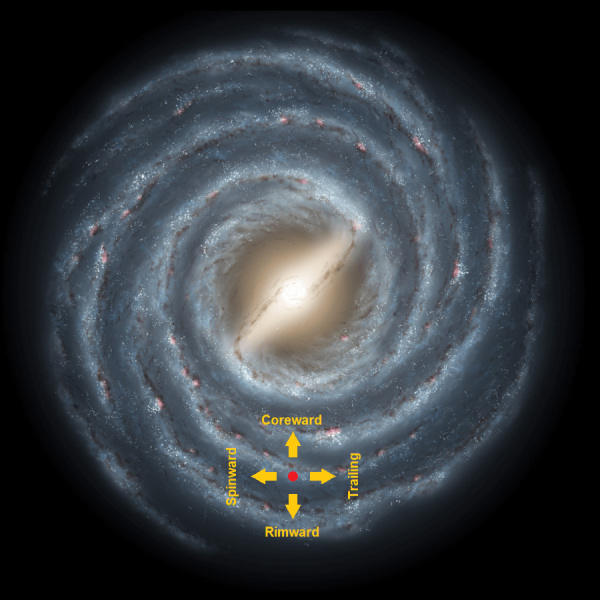Galactic Directions
The Galactic Directions are used in the arts and sciences of mapping out and navigating space as are astrography and astrogation.
- Jumpspace mapping and Normal Space (N-space) navigation are different fields.
Notes[edit]
- Astrography is the art and science of mapping out interstellar space. An astrographer is someone who maps out interstellar space.
- Please see Astrography for more information.
- Astrogation is the actual planning of the navigation of spacecraft. or a route through space, either in interplanetary or interstellar travel. An astrogator is someone who navigates a spacecraft, or starship, through interstellar space.
Description (Specifications)[edit]
North, South, East, and West are insufficient terms for referring to directions within the galaxy. Instead, the following conventions have achieved widespread acceptance when referring to direction.
- These directions are in widespread use in describing Imperial features and businesses. For example, the Spinward Marches is a sector at the extreme spinward fringe of the Imperium; Rimward Lines is an important interstellar transport company.
- Please see Spinward, Coreward, Rimward and Trailing for more information.

(Chart sourced from Traveller Map)
- Charted Space is marked in red.
Planar Disc Directions[edit]
Coplanar directions within the Galactic Plane may be specified as follows:
Coreward[edit]
Toward the galactic core (INWARD: center of the galaxy, toward Core Sector from the Solomani Rim). Also, within the Imperium, the term coreward is also used to indicate the direction of Capital, the Imperial core. There is some potential for confusion if the term is accepted out of context.
- Coreward (Towards the center of the Known Galaxy)
Rimward[edit]
Toward the rim (OUTWARD: far edge) of the galaxy, which is towards the Solomani Rim from Core sector.
- Rimward (Away from the center of the Known Galaxy)
Spinward[edit]
Towards the direction the galaxy is rotating or spinning, which is towards the Spinward Marches from Vland.
Trailing[edit]
Opposite the spin of the galaxy which is toward Vland from the Spinward Marches.
Perpendicular Disc Directions[edit]
When necessary, directions above or below the Galactic Plane may be specified as follows:
Galactic North[edit]
The direction above/perpendicular (i.e. "out of the diagram above") to the galactic plane relative to the planar coordinate system of the galaxy (right-hand rule)
Galactic South[edit]
The direction below/perpendicular (i.e. "into the diagram above") to the galactic plane relative to the planar coordinate system of the galaxy (right-hand rule)
History & Background (Dossier)[edit]
Non-canon: Multiple and often competing authorities take a variety of frequently confusing and ad hoc descriptions to use when speaking of areas of charted or mapped space. The Commonwealth of Deneb uses a standardized, if informal, set of rules to determine direction and location for celestial objects in relative proximity:
Space is divided into four “cardinal” directions, using the Galactic North Pole and the Milky Way Galaxy’s apparent clockwise rotation as a reference:
- These are “Spinward”, which is in the same lateral direction as the galaxy’s rotation.
- “Trailing”, which is complete opposition to the direction of rotation.
- “Coreward” which refers to moving in the direction of the galactic center, and...
- “Rimward” to refer towards moving in the direction of the galactic rim and termination.
Notes: Because the galaxy is a round, moving structure, these are relative directional terms rather than astrographic terms.
Directional Terminology[edit]
When areas of charted space overlap between more than one directional bearing, standard custom is to use a clock pattern to assign them in order, with the direction first on the clock taking precedence, followed by the succeeding direction separated by a hyphen.
- Hence the “upper left” quarter of a Subsector or sector is called the “Spinward-Coreward Quadrant,
- The upper right is called the “Coreward-Trailing Quadrant”,
- The lower right is the “Trailing-Rimward Quadrant”, and...
- The lower left is the “Rimward-Spinward Quadrant.”
Movements along an angular vector that lies between two directions is handled similarly, so that a ship moving from the upper left quadrant to the lower right is on a “Trailing-Rimward Vector.”
Notes: It is worth noting that the round nature of the galaxy actually mitigates against the imposition of straight boundaries close to the galactic center. Real sector and Subsector boundaries are actually curved, with the degree of curvature determined by the distance from the galactic center, or triangular when close to the Galactic Core. Fortunately, at the distance from the Core the Commonwealth and its surrounding environs finds itself, the degree of curvature is so small that boundaries can be treated as straight lines and a rectilinear Astrography can be used for gross description of Charted Space.
Sociocultural Terms of the New Imperial Age (1251; Unrevised Edition)[edit]
Non-canon: The common people of the Commonwealth of Deneb, and most astrographers, tend to popularly divide the space within and around their country into four distinct regions. The terms used for these regions are the most commonly used verbal shorthand in conversation regarding Astrography. Terms used to delineate someone’s specific astrographic origins are less commonly used, being primarily for official business with governments, customs and taxation purposes. To say that someone is from the Stronghold is less important than to say that he or she is a “Metropolitan”. Similarly someone from Knokseng Commonality is more likely to be called an “Outlander”, even though they are not part of that cultural group. The four regions are:
Metropolitan[edit]
Non-canon: Term used to refer to the “urban” core of the Commonwealth. This is roughly a 5x5 Subsector region centered upon Gulf Subsector (Deneb M), those subsectors falling in the Rift being irrelevant of course. As such the region encompasses all of the Stronghold and Sabinar Federation, the non-Rift Islands Federation, most of the People’s Republic, and the trailing sections of Enterprise and Abyss Federations. These regions are considered to be settled, with few pockets of underdevelopment, and under the firm control of the Commonwealth government and its Federal constituents (though the outsystems are less certain; see Outlands below). The chances of sophont-made danger in these areas are minimal beyond accidents or extreme mayhem. These regions are generally within six jump-6s of Mora, which means that information arrives at or from the capital with an acceptable degree of timeliness, which allows for greater cooperation and reliance between local governments.
When a person is referred to as a Metropolitan, it implies either a cultivated or civilized person with education and self-discipline, or a stuffy tender footed nag who is out of their depth in the wilder and woollier parts of the Commonwealth and Outlands. Metros are more likely to vote for persons and referenda that directly address urban issues or larger populations. They have a more casual attitude towards technology, are more apt to form self-interested factions or groups, and tend to value science and rationality (at least stereotypically) or be more familiar with the workings of technologies and integrated systems. Among less settled populations they are usually called greenhorns, tenderfoots or (among the Zhodani) “sweatbacks”.
Frontier[edit]
Non-canon: Term used to refer to non-metropolitan constituent regions of the Commonwealth. These include all of Corridor sector, the Pretoria Federation and Monoceros Federations, High Zhdant, Arden and the adjacent Sword World and Darrian Commonalties, the spinward majority of Enterprise and Abyss, the Rift Islands counties, and rimward portions of the People’s Republic. These regions have their own defined metropolitan high population worlds, but their politics are more locally focused and distinguished. A person from the Frontier is regarded as being more emotional, more self-reliant, have more traditional values, and possessing less trust in centralized government and cohering political systems. They are more supportive of their neighbors, but more apt to distrust strangers. They tend to support people over technology much more than Metros. The chances of danger or novel situations created at the hands of sophonts are much more likely, and the military and local Patrol garrisons are often under some strain in meeting their responsibilities. These regions are more than six jump-6s away from Mora, straining information flow, and requiring that local governing institutions from the Commonwealth level down must exercise more personal discretion in dealing with emergencies.
Being a Frontiersman implies to others a buckskin (or its 58th century equivalent) wearing galoot handy with both a pistol and his mouth, or simply someone who is more at home in the wilderness. Which is odd, given the most frontier Federations are as heavily urbanized as the Metropolitan regions, but myths die hard. There is a tendency among Metros towards either sniffiness or romanticism when they meet Frontiersman from more remote regions of Reft or Corridor. Among governing elite, these are bureaucrats and leaders that have operated autonomously on their own and therefore have the skills to buck the bad habits and insular groupthink that their Metro counterparts labor under.
Outlands[edit]
Non-canon: Term originally referred to those political units loyal to the Commonwealth that existed in the Badlands (areas beyond the 100 diameter line of a MainWorld), but now refers to those and a region within twenty parsecs of the Commonwealth boundaries. The latter include active Occupation Zones in Foreven and Ziafrplians sectors, Commonalties like Kedzudh and Knokseng in the Vargr Extents, and the Vilani March and adjacent states in Vland sector. These include independent states like Newcastle Reach, Thirz Empire and Urrllaer Union. Trailing portions of Tienpevnekr and the local Iebijipr are included as well as the Florians, the remnant Aslan Hierate in Trojan Reach, the Marrakech Trade League and some areas of Verge and trailing Reft sectors. Unlike the first two regions, Commonwealth control over the Outlands is conditional and subject to either local sovereignty or contingencies. Unless the state is friendly, or sufficient firepower is carried, the safety of ships and persons passing through this region cannot be reliably guaranteed by the Commonwealth. Most of these are on good terms with Deneb, and people who follow local laws, recognize local customs and show proper discretion in their dealings are usually unmolested.
Sweep[edit]
Non-canon: The name for regions beyond the twenty parsec perimeter comes from the term “the sky as defined by the sweep of the hand.” This includes nearly the entire galaxy, but for useful reasons refers to those states on this side of the Great Rift and Windhorn, or to trailing outside of the Fourth Imperium’s boundaries, that are both beyond twenty parsecs, and are either hostile or indifferent to the Commonwealth. These include a coterie of militant empires like the Aslan Saiwoaoh Kerlftaos, the “Zhodani” Klieliedrezh Empire of distant Chtierabl sector, and the Mad Dog Pact of Windhorn/Meshan sectors. The Fourth Imperium is usually not included, nor is the new Terran Sphere, mainly because of the limited trade and contact between those states and Deneb, and are given their own exclusive places in language and maps. The Commonwealth has no control over these regions beyond a few fleets, Pathfinder Lifesaver teams, and official embassies and consulates (where these are permitted by local governments).
References & Contributors (Sources)[edit]
- Classic Traveller Supplement 8: Library Data (A-M)
- Classic Traveller The Traveller Book
- Anonymous Time Traveller, "Sociocultural Terms of the New Imperial Age (1251; unrevised Edition)"
